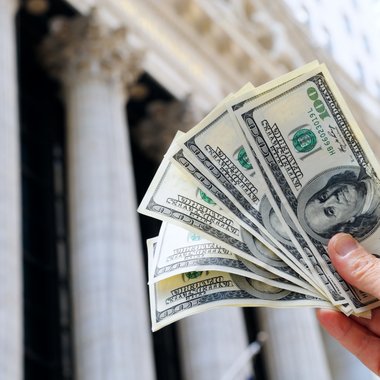How eCash can help graduates who are falling behind on student loan payments
May 12, 2022Most Americans think a college education is important. But for a growing number of young people, the cost of attending and obtaining a degree is increasingly prohibitive.

Between 2000 and 2020, the cost of a college education more than doubled, rising at a rate of 6.8% a year.
More to the point, while college-educated employees earn, on average, 75% more than those with high school diplomas, a college degree doesn't guarantee a high-paid job.
And for those college graduates who find themselves working for low wages and living paycheck to paycheck, paying off hefty student debt is a constant struggle.
How much does college cost?
The latest figures from the Education Data Initiative put the cost of a 4-year degree program at up to $27,023 a year at a public college and up to $35,807 a year at a private college.
And those numbers just cover tuition.
Once you factor in the cost of books, stationery, and other study materials, accommodation and living expenses, and interest on student loans, the cost of a bachelor's degree can reach $53,217 a year or more — an eye-watering $212,868 over four years.
Unsurprisingly, 51% of college graduates say student debt has forced them to postpone important life milestones like getting married, buying their first home, and having children.
Worse, student debt is putting a significant number of graduates in financial difficulty.
According to the Department of Education's official statistics, 30% of graduates are in arrears, stop making repayments, or default on their student debt within six years of graduation.
Stuck in a rut
While the COVID-19 pandemic has had a significant impact on the job market — in 2020, only 50.2% of graduates landed a well-paid job within six months of graduating — the number of graduates working low-paid jobs and struggling to repay their student loans has been rising steadily for years.
Salaries for entry level jobs requiring a college degree are at all-time highs. But so is competition for those jobs.
As a result, according to the Federal Reserve Bank of New York, employees aged 22 to 27 with a bachelor's degree or higher are more likely to be unemployed or underemployed — that is, working low-paid jobs they're overqualified for — than any other demographic.
With salaries of $25,000 a year or less and a job market that's making it tougher for them to improve their prospects, these employees struggle to meet the cost of rent, utilities, and other day-to-day expenses, let alone repay their student debt.
But even when they do manage to scrimp and save to pay a chunk off their student debt, they face two critical hurdles.
Firstly, many low-paid jobs — particularly those in hospitality and the gig economy — are paid at least partly in cash.
Secondly, low-paid employees are more likely to be unbanked or underbanked, because income and access to banking are strongly correlated.
When the Federal Deposit Insurance Corporation surveyed households to find out how they bank, 50% of respondents who didn't have a bank account said this was because they were unable to meet minimum deposit requirements or afford the fees.
Put simply, the less money you have, the more expensive it is to access financial services.
Making student loan payments easier with eCash
Because of their dependence on cash and limited or no access to traditional banking services, graduates working low-wage jobs often find themselves trapped in a vicious cycle, unable to pay their debts.
Meanwhile, interest continues to accrue and the debt grows more unaffordable.
While the student debt crisis is down to various complex reasons, many of which date back decades, it's clear that the choice of payment methods isn't helping. Student loan companies don't accept cash. So low-wage earners who can't access a bank account, debit card, or credit card, can't make repayments, even if they have set money aside.
 | Jan Marc Kuelper SVP, Enterprise Sales, North America | Expanding payment methods to include an eCash solution would give graduates an opportunity to break the cycle by allowing them to pay using a payment method they have ready access to. |
Expanding payment methods to include an eCash solution would give graduates an opportunity to break the cycle by allowing them to pay using a payment method they have ready access to.
But student loan companies also stand to benefit, because they can reduce the number of student loans in forbearance or default through a reliable, cost-effective payment method that's preferred by customers who would otherwise struggle.
Accepting payments through eCash is as simple as embedding a barcode into the monthly loan statement. The statement can be mailed or downloaded electronically. And, once it's received, it can be printed out, taken to the closest payment point, and settled in cash.
Crucially, student loan companies don't have to open physical locations or hire more employees in order to accept cash payments. Companies offering eCash payments have a broad network of up to 70,000 stores across the U.S. where anyone can walk in, scan the code on their bill, and pay in cash.
College should broaden your horizons, not bury you in debt
At a massive $1.7 trillion in November 2021 — second only to mortgage debt — student debt has hit critical levels.
But what's worse is that those from lower socio-economic backgrounds are more likely to be negatively affected.
Rising costs mean they have to borrow more to afford going to college. In turn, they're also more likely to struggle to repay their student loans. Which means that what has traditionally been a way for people to improve their prospects is increasingly making things worse.
As the Center for American Progress — an independent, non-partisan policy institute — notes:
"Understanding who defaults [on student debt] and why matters not just because of the severe consequences borrowers face when they end up in this situation..."
"Young people who watch parents or peers losing much-needed tax refunds from student debt or hearing that college was not for them may become skeptical of the benefits of pursuing postsecondary education."
While there are no easy solutions or quick fixes, offering graduates more payment choices can make a significant difference.
Enabling graduates to use eCash can ease the burden by making repayments more convenient and accessible for everyone, regardless of who they are, how much money they make, and whether they have access to a bank account.

